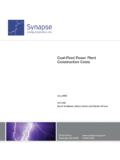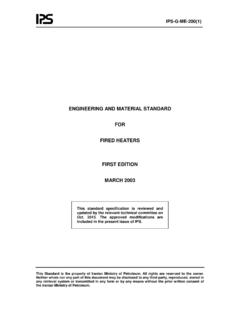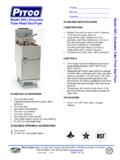Transcription of Fired Heater Optimization - analitech.ru
1 Fired Heater Optimization Francis Wildy Technical Sales Support Manager AMETEK Process Instruments 150 Freeport Road Pittsburgh, PA 15044 KEYWORDS Process Optimization , Fuel Efficiency, Fired Heater , Oxygen, Combustibles, Radiant Zone ABSTRACT Process heaters , furnaces and Fired heaters account for most of the energy costs associated with running hydrocarbon processing and chemical plants. Continuous measurement of both oxygen (O2) and combustibles in the radiant section of the Heater provides the information needed for effective Heater operation with significant benefits in energy savings, NOx (oxides of nitrogen) reduction, product quality, product throughput, Heater and tube life, as well as safety. Widely varying fuel values, high temperatures, multiple burners and multiple cells provide special challenges to combustion Optimization in Fired heaters .
2 This paper will discuss how reliable, properly located high-temperature oxygen and combustibles analyzers help meet Heater performance objectives with minimal investment cost. A practical approach to setting up a Heater will be outlined, along with examples of energy savings and NOx reduction. INTRODUCTION A Fired Heater is a direct- Fired heat exchanger that uses the hot gases of combustion to raise the temperature of a feed flowing through coils of tubes aligned throughout the Heater . Depending on the use, these are also called furnaces or process heaters . Some heaters simply deliver the feed at a predetermined temperature to the next stage of the reaction process; others perform reactions on the feed while it travels through the tubes. Fired heaters are used throughout hydrocarbon and chemical processing industries such as refineries, gas plants, petrochemicals, chemicals and synthetics, olefins, ammonia and fertilizer plants.
3 Most of the unit operations require one or more Fired heaters as start-up Heater , Fired reboiler, cracking furnace, process Heater , process Heater vaporizer, crude oil Heater or reformer furnace. Heater fuels include light ends ( refinery gas) from the crude units and reformers as well as waste gases blended with natural gas. Residual fuels such as tar, pitch, and Bunker C (heavy oil) are also used. Figure 1 shows a natural draft process Heater with inspiration type burners. Combustion air flow is regulated by positioning the stack damper. Fuel to the burners is regulated from exit feed temperature and firing rate is determined by the level of production desired. FIGURE 1 ILLUSTRATION OF Fired Heater WITH SIDE VIEW OF TOP SECTION Radiant Section: The radiant tubes, either horizontal or vertical, are located along the walls in the radiant section of the Heater and receive radiant heat directly from the burners or target wall.
4 The radiant zone with its refractory lining is the costliest part of the Heater and most of the heat is gained there1. This is also called the firebox. Convection Section: The feed charge enters the coil inlet in the convection section where it is preheated before transferring to the radiant tubes. The convection section removes heat from the flue gas to preheat the contents of the tubes and significantly reduces the temperature of the flue gas exiting the stack. Too much heat picked up in the convection section is a sign of too much draft. Tube temperature is taken in both convection and radiant sections. Shield Section: Just below the convection section is the shield (or shocktube) section, containing rows of tubing which shield the convection tubes from the direct radiant heat. Several important measurements are normally made just below the shield section.
5 The bridgewall or breakwall temperature is the temperature of the flue gas after the radiant heat is removed by the radiant tubes and before it hits the convection section. Measurement of the draft at this point is also very important since this determines how well the Heater is set up. This is also the ideal place for flue gas oxygen and ppm (parts per million) combustibles measurement. Stack and Breeching: The transition from the convection section to the stack is called the breeching. By the time the flue gas exits the stack, most of the heat should be recovered and the temperature is much less. From a measurement point of view, this location places fewer demands on the analyzer but is much less desirable for the ability to control the process. Measurement of stack emissions for compliance purposes is normally made here.
6 MEETING PERFORMANCE OBJECTIVES The performance objectives of process heaters are to maximize heat delivery of the process-side feed while minimizing fuel consumption, maximize heat delivery with varying fuel quality, minimize Heater structural wear, minimize stack emissions and maximize safety integrity levels. Proper monitoring and control brings benefits and avoids problems in the following areas of Heater operation: ENERGY SAVINGS Energy costs represent up to 65% of the cost of running a chemical/petrochemical/refining complex2. Furnace and Heater fuel is the largest component of this cost. Correct use and placement of gas analyzers can conserve the amount of fuel used and maximize Heater efficiency. When waste fuel was cheap, the excess was often flared with little reason to seek efficiency improvements.
7 Today many refinery processes require hydrogen (H2), and a lot of the hydrogen-rich off-gases, which were previously used as Heater fuel, are needed to meet this demand. Natural gas, which is now very expensive, is used to make up shortfalls. The more energy that can be squeezed from existing plant fuels, the less supplementary natural gas is required. NOx REDUCTION Stringent emission limits require greater control of NOx and other stack components. Operating the Heater at optimum efficiency, with low excess air firing is the simplest and least expensive way to reduce NOx emissions3. PRODUCT QUALITY AND THROUGHPUT Gases with widely varying calorific content are now widely used as fuel for heaters . This can produce large variations in heat delivered in the radiant section, and therefore, to greater demands on control of combustion to maintain the product or feed temperature.
8 Localized heating can lead to coking and a drop in capacity. Temperature control of the process tubes and reactions is critical in reforming and cracking operations. SAFETY No information or incorrect information from a poorly placed analyzer can lead to unsafe operation of heaters from air leaks, tube leaks, and fuel or burner problems. Most furnace incidents occur during startup4. Purgedown and lightoff cycles require special care and warrant consideration of methane monitoring in addition to oxygen and ppm combustibles. Heater AND TUBE LIFE Incorrect operation leads to premature failure, structural damage or tube leaks due to flame impingement, secondary combustion and flue gas leaks5. FACTORS AFFECTING PROCESS Heater OPERATION Process heaters offer particular challenges for measurement and control due to high temperature in the radiant zone, multiple burners, multiple cells, widely varying fuel calorific value, low investment in Heater Optimization and the difficulties associated with low NOx burner operation.
9 Factors affecting safe and efficient process Heater performance include draft, burner operation, and NOx production. DRAFT Optimum operation requires that excess air in the flue gas entering the convection section be minimized and there should be a very small negative pressure at the convection section inlet. 2a 2b 2c FIGURE 2 ILLUSTRATION OF CORRECT AND INCORRECT DRAFT Excessive draft, either positive pressure or negative pressure, can lead to severe problems. CORRECT DRAFT Figure 2a shows a process Heater operating with correct draft. Stack dampers and secondary air registers affect the draft and both adjustments are related. The hot gas pushes so that the pressure is always greatest at the firewall. The stack draft pulls and when correctly balanced the pressure at the bridgewall should be close to zero or very slightly negative.
10 A process Heater operating properly will have a zero, or slightly negative draft, at the shield section of zero to " wc (water column). The firebox will be slightly positive (+ to + " wc) and the stack will have a range of to " wc. EXCESSIVE DRAFT - POSITIVE PRESSURE CREATED The pressure is always greatest at the firewall. In Figure 2b, the air registers are wide open and the damper mostly closed. This generates a positive pressure which forces flue gases outward through leaks in the convection section leading to serious structure damage, as well as heat loss. EXCESSIVE DRAFT - NEGATIVE PRESSURE CREATED The air registers are mostly closed and the stack damper is wide open (Figure 2c) leading to a high negative pressure in the convection section. Cold ambient air is sucked in through leaks in the convection section leading to erroneous oxygen readings, as well as heat loss; excessive draft causes tall flames that can reach the tubes resulting in serious damage.







